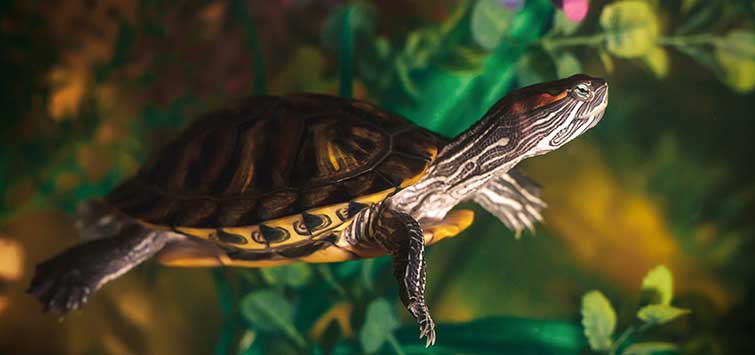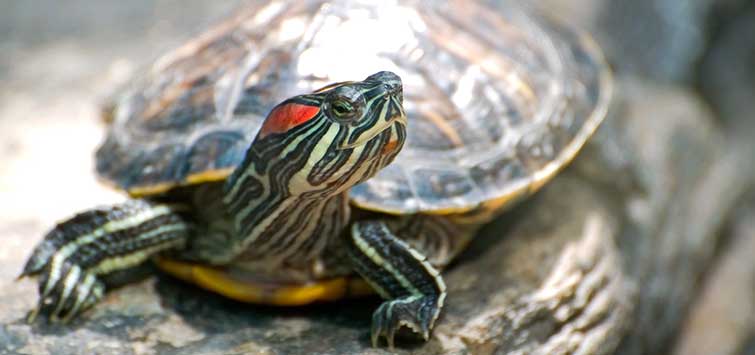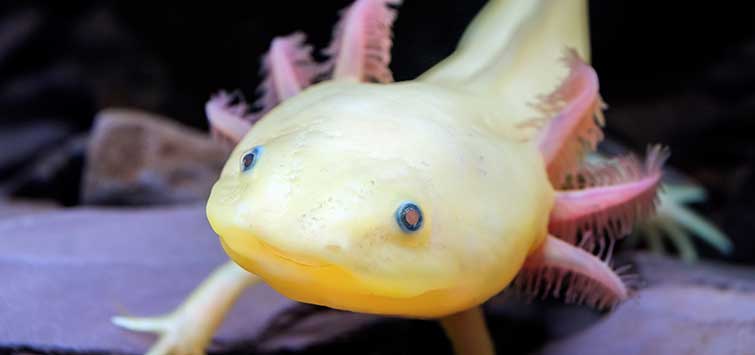Going Reptilian: An Aquarist's Introduction to Turtles
Author: Paul Demas
Turtles can make fascinating and endearing aquarium residents, but their care requirements are much different than those of other aquatic pets—and very important to follow.
Behold the turtle. It only makes progress when it sticks its neck out.
—James Bryant Conant
What a Catch
It was a beautiful day in the picturesque Catskill Mountains. My brother and I were hunting the shorelines, along with our little sister, who kept pulling out the fish from among the newts and frogs in our buckets to kiss them because she thought they were cute. I saw something crawling on the bottom of the lake. I couldn’t let it escape. I scooped my net and brought up a hatchling snapping turtle—my best find ever! Thus began a lifelong fascination with turtles.
Keeping turtles was a natural way for my aquarium hobby to evolve. Why do many aquarists include one or more turtle tanks in their collections? Like fish, turtles can be fascinating to watch. Many have attractive colors and markings, along with interesting behaviors. They are also pets to be watched, as they don’t enjoy being handled; they are not even like some snakes and lizards that enjoy lounging on the shoulders of their owners. On the other hand, the fact that turtles do not like to be cuddled and do not require constant attention can really be an advantage—something an aquarist can appreciate. This does not, of course, preclude one-on-one interaction with a pet turtle.
Feeding
Like cichlids or triggerfish, turtles recognize their owners and beg for food. One of my turtles is an eastern painted turtle that will eagerly accept food from my hands. In fact, it will climb out of the water onto its basking platform to get food, and then dive back into the water to eat. Everybody gets a kick out of it when we perform this trick for them—apparently even the turtle.
Don’t Release Your Turtle into the Wild
With a lifespan of 30 years or more, a turtle does require a long-term commitment. The longevity of turtles is a plus for me, but you need to seriously think about it when considering adding a turtle to your collection. Aquarists will not be surprised by my warning that you should never—and I mean never—release your unwanted turtles into the wild. The possible consequences of releasing any plant or animal include destruction of the local ecosystem and a likely death for the specimen, not to mention the risk of fines and imprisonment for the irresponsible person doing the release. Even if an animal is native to your area, releasing captive stock risks introducing non-native diseases to the local populations, as well as having the captivity-softened animal die.
Requirements
Depending on species, a turtle may be rather inexpensive, but as with fish, certain species have a giant price tag. Any turtle requires an investment for a tank or other habitat, filtration, lighting and heating equipment, etc. Get a sufficiently large habitat from the start. Depending on species, that cute little 4-inch turtle may one day be 12 inches long or more.
Housing
When some people think of turtlekeeping, they picture one of those small plastic turtle bowls with a fake tree. Unfortunately, those bowls are like goldfish bowls—they doom their inhabitants to a miserable existence and premature death. Turtles have specific needs that must be met, and turtle bowls meet none of them. To properly house a turtle, you must first learn about the species of turtle you are interested in, since different species of turtles can have different requirements. A lot—but not all—of your experience with keeping fish will come in handy for turtlekeeping. Remember, just as with maintaining aquariums, there is no one right way to keep a turtle, and you will encounter plenty of different advice, some of it less than useful—even counterproductive.
Observations to Make
Does the turtle you’re interested in bask regularly, or does it never leave the water except to lay eggs? Is it an active predator, energetically chasing down fish meals, or is it an ambush predator that lies on the bottom waiting for prey to swim or crawl by? Is it full-grown when you buy it, or will it grow much larger? Does it eat primarily vegetation or meat, and does its proper diet change as it grows into adulthood? Is it a peaceful animal, or will it harass or attack tankmates? Well, you need to know these things before you can set up the habitat, and you need to set up the habitat before you obtain your turtle. Do those questions seem familiar? The tragedies that can result from impulse buying of tropical fish can also result when you buy a turtle unprepared.
Aquarium Options
Glass aquariums are the most popular type of turtle housing. They are very easy to clean, which is of great importance, and they enable you to view from the side, through the glass. Other options for housing include plastic tubs and containers, many of which work out nicely for turtles. They also can make great temporary houses or feeding tanks. You can only view your pet from the top, however, and you have to be careful using heaters and heat lights with such enclosures, which can melt or catch fire. Another option is an indoor pond, and perhaps an outdoor pond in the summer. While many people build an outdoor pond for fish, as a kid I built one for turtles, and it really let me enjoy their natural behavior.
The size needed will vary depending upon species, but bigger is always better. While a hatchling or juvenile turtle can be kept in a smaller tank, a larger tank—perhaps much larger—will soon be required. A 30-gallon tank is the absolute minimum for a single turtle of the smaller species, and if you plan on keeping a larger animal, or more than one, you will need a 50-gallon tank or even larger. Breeder tanks are excellent, since they provide plenty of room for turtles to swim and turn around in.
Decorating the Tank
Few fish make specific demands on how you decorate their tank, and part of the fun of owning an aquarium is decorating it. However, turtles need a different approach. For most, a minimalist approach is best, avoiding substrate and decorations. Softshell turtles need a soft sand substrate in order to thrive, and in most cases gravel on the bottom of the tank is just a dirt magnet. Almost any turtle will quickly destroy an aquascape, eating or shredding plants and knocking over decorations. A barebottom tank with no ornaments is best.
Basking Spot
A basking spot is one essential accessory for most aquatic turtle tanks. You have probably seen several turtles sitting on a log, sometimes piled on top of each other, legs stretched out, soaking in the rays of the sun. Most aquatic turtles have to bask if they are to survive and grow properly in our care. Basking enables a cold-blooded turtle to regulate its body temperature and allows it to absorb vital UVB rays.
A basking spot can be as simple as a large rock or piece of driftwood on which your turtle can easily climb completely out of the water. Be careful when piling rocks on top of each other; these animals are strong and can knock over an unsteady rock pile, often with tragic consequences, since a turtle will drown if it is pinned and cannot reach the surface to breathe. There are also commercially made basking spots. A suitable spot will allow your turtle to climb completely out of the water and will support its weight; if you plan on keeping more than one turtle, it will be strong and roomy enough for them all. It must also remain stationary, as a floating platform that does not remain under the light source does not serve its purpose. Whether you buy or make one, consider that a floating platform that can be fixed in place under the light with suction cups or by some other means has an advantage over a chunk of rock. Rocks take up a lot of space, cutting down on the vital swimming room.
A great do-it-yourself project is an above-tank basking platform that rests on top of the tank, which is filled all the way. It is enclosed by walls to keep the turtle inside, and has a ramp to allow the turtle to climb onto it. This basking spot allows a deeper swimming area, and it also allows you to use any type of filter that you wish. Normally, due to the lower water levels in a turtle tank, you are restricted as to what kind of filter you can use.
Filtration
If you keep very large fish, you know how messy they can be. A turtle is worse—a very messy eater that produces a great deal of waste. Filtration plays a key role in keeping the turtle’s housing clean and maintaining its health. Both mechanical and biological filtration are very important in a turtle setup, since water cleanliness and quality are as vital to your success with turtles as they are with fish. A popular type of filter used by many turtlekeepers, especially in smaller tanks, is an internal power filter that is completely submersible and can be used in tanks with low water levels, but they have the disadvantage of taking up valuable space in the tank. My favorite choice for a turtle tank is a canister filter—they are very powerful, can easily handle low water levels, and do not take up tank space. A hang-on power filter cannot usually be used on a partially filled tank, but manufacturers make special turtle tanks with a cutout at one end that allows you to hang a power filter at the water level.
Regardless of how good the filtration is, water changes are a necessary part of turtle care. Frequency will depend on several factors, such as the amount of water the enclosure holds, size and number of turtles, whether or not you use decorations and substrate, and if you feed your turtle in its housing or in a separate feeding tank. It will probably be necessary to do weekly water changes in order to maintain clean water for your turtles; as with fish, the more frequent the water changes, the better it is for your turtles.
From time to time you should completely take down your turtle enclosure and give it a thorough cleaning. While this practice would almost never be recommended for a fish tank, for a turtle tank it should be a regular part of your routine. You can use a diluted bleach solution or white vinegar to disinfect the emptied tank, just make sure to rinse thoroughly afterwards.
Lighting
The correct lighting will provide your turtle with three key elements that are vital to its well-being. These are elements that a turtle would normally get from exposure to sunlight in the wild: UVA, UVB, and heat. Let’s look first at a turtle’s UV requirements.
UV (ultraviolet) light from the sun comprises three categories of wavelengths: UVA, UVB, and UVC. The first two are important for turtles, but aquarists are most familiar with UVC, which is used in UV sterilizers. No UV light is visible to humans, but most if not all reptiles can probably see UVA wavelengths, and UVA exposure is important for many turtles because it induces natural behavior such as feeding and reproduction. Most reptile bulbs on the market will give off the necessary UVA. Many of the bulbs offered for reptiles also provide the more important UVB lighting.
Why UVB?
UVB is essential for your turtle’s health and growth. It allows for the synthesis of vitamin D3, which in turn allows for the absorption and metabolism of calcium. All the calcium in the world will not do any good for your turtle unless it has the needed vitamin D. Thus, correct UVB exposure is essential for the development of a healthy skeletal system, and without it your turtle will have such problems as poor shell growth, metabolic bone disease, and a shorter life span. While a few species of turtles do not require UVB, if a turtle basks, you can assume that it requires UVB lighting. UVB bulbs are offered in different percentages; you should choose a bulb that emits 5 percent UVB.
Bulbs
UVB bulbs may be fluorescent, compact fluorescent, or mercury vapor. The most common are fluorescent, which are fairly inexpensive and reliable. They require more expensive fixtures, but many aquarists already have fixtures that would work perfectly for them. Many compact fluorescents are made to fit standard incandescent sockets and are often put into an inexpensive clamp-on fixture. Newer to the market are mercury-vapor bulbs that also fit in a standard incandescent fixture. They also give off heat and can provide UVB lighting at greater distances—up to several feet as opposed to the average 6 to 12 inches for the others.
Lighting Strategies
UVB lighting cannot penetrate glass, so don’t use a glass top for your turtle enclosure. Even a fine mesh top can block UVB, so a screen top should have the biggest possible openings. Keep in mind that reptile bulbs are similar to aquarium bulbs in that they lose effectiveness before burning out. Always follow the manufacturer’s recommendations for replacement, usually every six to ten months. Also pay attention to their proper placement, which must be the correct distance from the basking spot. As a general rule, regardless of the type of bulb, you’ll want to provide approximately 10 to 12 hours of exposure per day. A timer makes it easy to keep this photoperiod constant.
Temperature Zones
Fish usually do best with one constant temperature in the aquarium, but turtles need different temperature zones. A turtle basks so that it can raise its body temperature, which in turn increases its metabolism and aids in digestion. After basking, a turtle needs to be able to dive into cooler water. The basking spot should be 85° to 90°F, heated by a separate incandescent light or a combination basking/UVB light. The water should be about 10 degrees cooler than the basking spot. Like some large cichlids, your turtle may be rough on the aquarium heater, so keep a close eye on it and protect it if necessary. Use thermometers to monitor the water temperature, as well as the air temperature at and away from the basking spot.
Nutrition
A poor diet is the cause of sickness in many turtles. You should offer a great variety of food to your turtle, just as you would for your fish. Like fish, different turtle species have different nutritional requirements. Research so you can meet your turtle’s specific needs. Remember that the diets of some turtles change as they mature.
Offer a Variety
One of the fun parts of caring for a turtle is feeding time. It seems they are always begging for food. Commercially available turtle diets have come a long way from the dried ant eggs that were included with those turtle death bowls half a century ago. Specially formulated turtle pellets or sticks should be the staple of a turtle’s diet. I offer my turtles several different brands, and I continually rotate them. My turtles also love koi food, which is very similar in composition to turtle food. It’s just another way to add a little spice to their diet. While pellets are an excellent source of food for our turtles, this should by no means be the only food that we offer them.
Commercial Foods
There are also plenty of other convenient and commercially available foods that we can use, many of which you might be already giving your fish. Hatchling turtles enjoy frozen or freeze-dried bloodworms. Krill or river shrimp make an excellent treat, and you may find freeze-dried crickets, grasshoppers, and snails for sale, all of which make excellent treats and help expand a turtle’s diet.
Plants
Plant matter is also very important and should be a regular part of the diet of omnivorous or herbivorous species. Many aquatic plants will be readily accepted by your turtle. If you maintain a planted fish tank, your turtle should welcome some of those cuttings you normally throw away. Romaine lettuce is good, and I have found that my turtles like dandelion leaves. Make sure when feeding plants that they are free of any herbicides or pesticides.
Live Prey
Live prey can increase the variety of food we offer our turtles, and for a few species it may even be necessary. Your turtle will readily accept various live insects, worms, snails, and small fish, all of which are often part of their natural diet. These can be gutloaded or dusted with calcium.
Don’t Overfeed
Giving in to a turtle’s begging can lead to serious health problems, including obesity. Feeding too much food will also increase the amount of wastes produced. Keep in mind that a healthy turtle will almost never turn down food. Recommendations vary, but a general guideline is to offer an amount of pellets roughly the equivalent of the volume of the turtle’s head (not including the neck), since a turtle’s head is about the same size as its stomach.
Hatchling turtles should be fed every day until they are about a year old. Older turtles should be fed every-other day (or smaller amounts every day). Another option is to feed a high-protein food like pellets one day and then offer plant matter the next day.
Provide Calcium
A well-balanced diet will take care of a turtle’s needs, but you might want to take the precaution of offering some form of calcium supplementation. I’ve already mentioned dusting or gutloading live prey. Another great option is cuttlebone—the same cuttlebone sold for pet birds. Cuttlebone will float in water and many turtles enjoy nibbling on it.
Feed in the Water
Turtles will only eat in water. Even my “performing” painted turtle that comes out to get food always returns to the water before eating it. Turtles are very messy eaters, so consider using a feeding tank—a separate container of water in which you feed your turtle. This avoids getting a lot of mess in the regular habitat. Also, many turtles will defecate within 30 minutes after eating, so if you can leave your turtle in its feeding tank for a while, you can keep even more pollution out of the main tank.
Turtle Species
Now let’s look at some of the more popular turtles available. Please do further research before deciding which turtle to get, paying special attention to adult size. There are so many species that all we can cover here are those you are most likely to find at your local pet store.
Red-Ear Sliders Trachemys scripta elegans
This is the first turtle that comes to mind for most people. It is unfortunately associated with those death bowls of yesteryear. But they are popular for good reason; they have beautiful markings and colors, including red markings on the side of the face. Red-ear sliders do get large, with females growing to 12 inches or more, so a large setup is necessary. They are also eager baskers and active swimmers. Like other sliders, they are omnivores, with their diet becoming more herbivorous as they mature. Historically they have also been the most abused or neglected turtles, and the most likely to be released to the wild. There are way too many unwanted red-ear sliders out there. This is one reason Florida recently banned these particular turtles. It is also available in beautiful pastel and albino morphs, both of which are still legal in Florida.
Yellow-Belly Sliders Trachemys scripta scripta
Many sliders and similar cooters are available besides the red-ear, but all of them have very similar care requirements. The yellow-belly slider is one of my personal favorites, a very hardy turtle with a striking yellow color, although as with many turtles, the colors fade as they mature. Yellow-bellies tend to be a bit smaller than the red-ear slider.
Painted Turtles Chrysemys picta
Closely related to the sliders, and with similar requirements, painted turtles are among the most beautiful turtles. There are four subspecies, the eastern C. p. picta, midland C. p. marginata, western C. p. bellii, and southern C. p. dorsalis, with one being more beautiful than the other. I highly recommend these turtles, as they make great pets. With the exception of the western painted turtle they are smaller than others, with some remaining in the 5- to 6-inch range.
Map Turtles Graptemys spp.
There are several different species of map turtles available. They have some of the most interesting patterns and shells of any turtle, which give them their common name. Map turtles can be among the more difficult-to-keep common turtles—clean water is an absolute must, or their health will quickly deteriorate. Many recommend that map turtles are best left to experienced turtlekeepers, but really the secret to success is clean water and a good diet. Most map turtles are omnivorous, although the diet of each species will vary slightly. They also tend to be a little on the shy side.
Mud and Musk Turtles Kinosternon spp. and Sternotherus spp.
These two types of turtles are very similar, and there are many different species available. While they don’t have the beautiful colors of some of the others, they do make for very hardy, interesting, and fascinating pets. They are also smaller—most under 7 inches, and some species a lot smaller. These turtles are decidedly aquatic and rarely leave the water, but a basking spot should still be available to them. They are not big swimmers, preferring to crawl on the bottom instead, and prefer shallow water. Provide some rocks so they will have a sure footing and perhaps even a hiding spot. For the most part, mud and musk turtles will eat almost anything, although they tend to be more carnivorous. Be careful, as these turtles tend to be a little nippy also. With so many different species available, make sure you research the type you decide upon to get more specific information.
Additional Turtle Varieties
By no means are these the only turtles available. Some other interesting turtles include the diamondback terrapin, which lives in brackish water, although they are restricted in many areas, and snake-neck turtles, which are also fascinating. Soft-shelled turtles are unique looking and require specialized care. Speaking of unique, there is the prehistoric-looking mata mata turtle, which requires a huge tank. Then there is the very large snapping turtle, which is not a turtle I would recommend for most people! Whichever you decide upon, if you follow the basic guidelines discussed here and do your research, the progression of your aquatic hobby into the world of turtles will be successful. So why not stick your neck out and get a turtle as a pet? You won’t be disappointed. Happy turtlekeeping!
Turtles & Fish?
With few exceptions, a fish tank is a terrible place to house a turtle. These animals have very different needs, and both cannot be properly cared for in the same aquarium. Plus, even a very small turtle will destroy an aquascape, and almost any turtle will happily dine on your prized tropical fish. Turtles should be housed separately from fish.
See the full article on TFH Digital http://www.tfhdigital.com/tfh/200804/#pg74

.png?h=595&iar=0&w=2781&hash=5FD5E69473BCC22199FBFA2FB71B6033)



